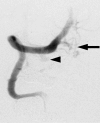Transarterial embolization of a cervical dural arteriovenous fistula. Presenting with subarachnoid hemorrhage
- PMID: 20569588
- PMCID: PMC3354601
- DOI: 10.1177/159101990601200404
Transarterial embolization of a cervical dural arteriovenous fistula. Presenting with subarachnoid hemorrhage
Abstract
We describe a case of a 75-year-old man who presented with acute onset of headache and subarachnoid hemorrhage and initial cerebral angiography was deemed "negative". In retrospect, a faint contrast collection was present adjacent to the right vertebral artery at the C1 level suspicious for a small dural arteriovenous fistula (dAVF). Follow-up angiography with selective microcatheter injections of the right vertebral artery and C1 radicular artery confirmed a complex dAVF with characteristically specific venous drainage patterns associated with a subarachnoid hemorrhage presentation. Subsequently, the cervical dAVF was treated with superselective glue embolization resulting in complete occlusion. Cervical dAVFs are extremely rare vascular causes of subarachnoid hemorrhage. Both diagnostic angiography and endovascular treatment of these lesions can be challenging, especially in an emergent setting, requiring selective evaluation of bilateral vertebral arteries and careful attention to their cervical segments. Although only a single prior case of a cervical dAVF presenting with subarachnoid hemorrhage has been successfully treated with embolization, modern selective transarterial techniques may allow easier detection and treatment of subtle pathologic arteriovenous connections.
Figures





Similar articles
-
Cervical spinal epidural arteriovenous fistula with coexisting spinal anterior spinal artery aneurysm presenting as subarachnoid hemorrhage--case report.J Stroke Cerebrovasc Dis. 2014 Nov-Dec;23(10):e461-e465. doi: 10.1016/j.jstrokecerebrovasdis.2014.07.012. Epub 2014 Oct 3. J Stroke Cerebrovasc Dis. 2014. PMID: 25284720
-
Acute subarachnoid hemorrhage in posterior condylar canal dural arteriovenous fistula: imaging features with endovascular management.J Neurointerv Surg. 2015 Jul;7(7):e26. doi: 10.1136/neurintsurg-2014-011273.rep. Epub 2014 Jul 8. J Neurointerv Surg. 2015. PMID: 25006042
-
Dural arteriovenous fistula of jugular foramen with subarachnoid hemorrhage : selective transarterial embolization.J Korean Neurosurg Soc. 2009 Mar;45(3):199-202. doi: 10.3340/jkns.2009.45.3.199. Epub 2009 Mar 31. J Korean Neurosurg Soc. 2009. PMID: 19352487 Free PMC article.
-
Complete Obliteration of a Foramen Magnum Dural Arteriovenous Fistula by Microsurgery After Failed Endovascular Treatment Using Onyx: Case Report and Literature Review.World Neurosurg. 2020 Dec;144:43-49. doi: 10.1016/j.wneu.2020.08.077. Epub 2020 Aug 15. World Neurosurg. 2020. PMID: 32805464 Review.
-
Intracranial subarachnoid hemorrhage resulting from cervical spine dural arteriovenous fistulas: literature review and case presentation.Neurosurg Focus. 2009 Jan;26(1):E4. doi: 10.3171/FOC.2009.26.1.E4. Neurosurg Focus. 2009. PMID: 19119890 Review.
Cited by
-
A Rare Case of Subarachnoid Hemorrhage caused by Ruptured Venous Varix Due to Dural Arteriovenous Fistula at the Foramen Magnum Fed Solely by the Ascending Pharyngeal Artery.J Cerebrovasc Endovasc Neurosurg. 2018 Jun;20(2):120-126. doi: 10.7461/jcen.2018.20.2.120. Epub 2018 Jun 30. J Cerebrovasc Endovasc Neurosurg. 2018. PMID: 30370246 Free PMC article.
-
Intraoperative DSA-guided minimal approach for craniocervical junction DAVFs obliteration.Acta Neurochir (Wien). 2023 Jun;165(6):1557-1564. doi: 10.1007/s00701-023-05585-8. Epub 2023 Apr 22. Acta Neurochir (Wien). 2023. PMID: 37086281
-
Varix Rupture Due to High-Flow Parasagittal Sinus Dural Arteriovenous Fistula: A Case Report and Literature Review.Cureus. 2025 May 8;17(5):e83760. doi: 10.7759/cureus.83760. eCollection 2025 May. Cureus. 2025. PMID: 40491610 Free PMC article.
References
-
- Kendall BE, Logue V. Spinal epidural angiomatous malformations draining into intrathecal veins. Neuroradiology. 1977;13(4):181–189. - PubMed
-
- Symon L, Kuyama H, Kendall B. Dural arteriovenous malformations of the spine. Clinical features and surgical results in 55 cases. J Neurosurg. 1984;60(2):238–247. - PubMed
-
- Kinouchi H, Mizoi K, et al. Dural arteriovenous shunts at the craniocervical junction. J Neurosurg. 1998;89(5):755–761. - PubMed
-
- Reinges MH, Thron A, et al. Dural arteriovenous fistulae at the foramen magnum. J Neurol. 2001;248(3):197–203. - PubMed
LinkOut - more resources
Full Text Sources

